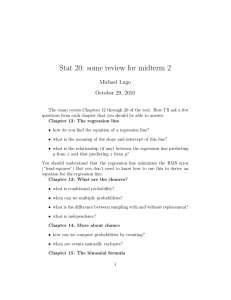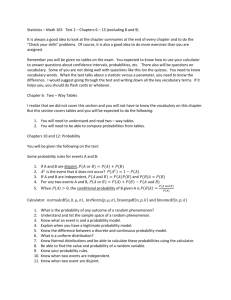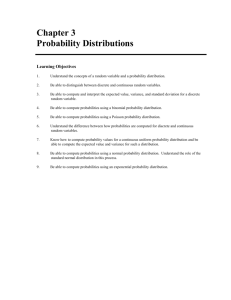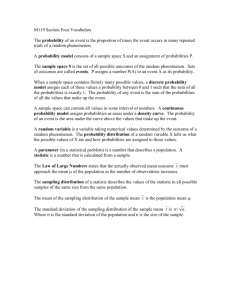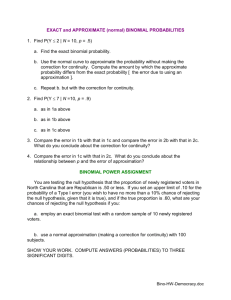Probability and Statistics Goals Trimester 2 2010 – 2011 1.1 What is
advertisement
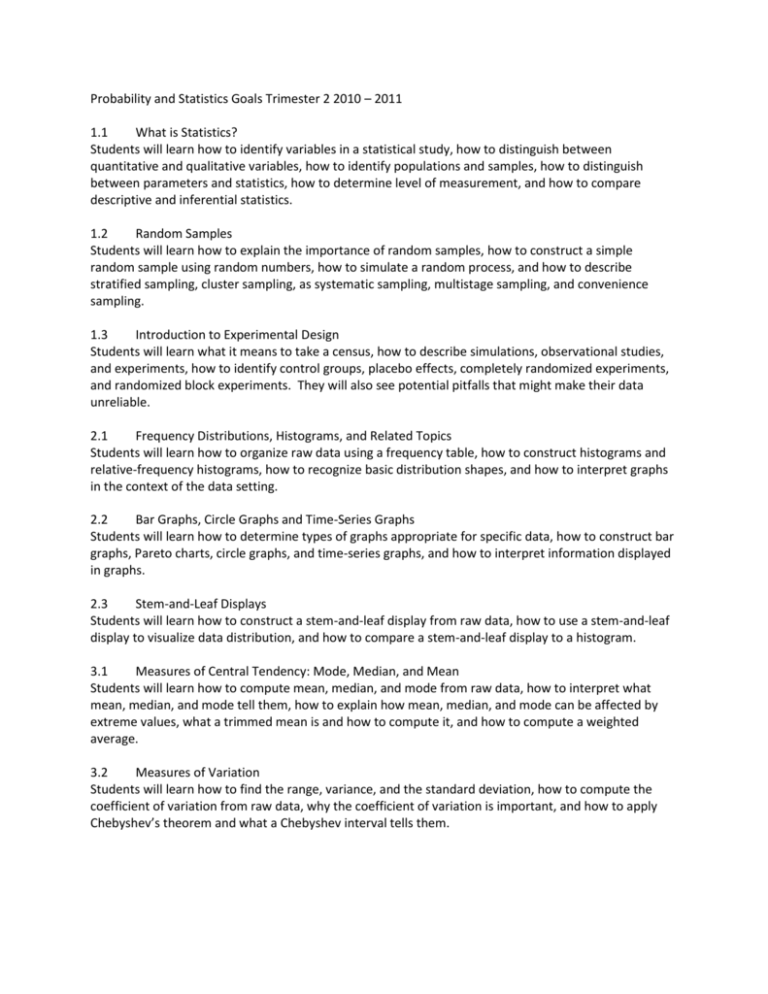
Probability and Statistics Goals Trimester 2 2010 – 2011 1.1 What is Statistics? Students will learn how to identify variables in a statistical study, how to distinguish between quantitative and qualitative variables, how to identify populations and samples, how to distinguish between parameters and statistics, how to determine level of measurement, and how to compare descriptive and inferential statistics. 1.2 Random Samples Students will learn how to explain the importance of random samples, how to construct a simple random sample using random numbers, how to simulate a random process, and how to describe stratified sampling, cluster sampling, as systematic sampling, multistage sampling, and convenience sampling. 1.3 Introduction to Experimental Design Students will learn what it means to take a census, how to describe simulations, observational studies, and experiments, how to identify control groups, placebo effects, completely randomized experiments, and randomized block experiments. They will also see potential pitfalls that might make their data unreliable. 2.1 Frequency Distributions, Histograms, and Related Topics Students will learn how to organize raw data using a frequency table, how to construct histograms and relative-frequency histograms, how to recognize basic distribution shapes, and how to interpret graphs in the context of the data setting. 2.2 Bar Graphs, Circle Graphs and Time-Series Graphs Students will learn how to determine types of graphs appropriate for specific data, how to construct bar graphs, Pareto charts, circle graphs, and time-series graphs, and how to interpret information displayed in graphs. 2.3 Stem-and-Leaf Displays Students will learn how to construct a stem-and-leaf display from raw data, how to use a stem-and-leaf display to visualize data distribution, and how to compare a stem-and-leaf display to a histogram. 3.1 Measures of Central Tendency: Mode, Median, and Mean Students will learn how to compute mean, median, and mode from raw data, how to interpret what mean, median, and mode tell them, how to explain how mean, median, and mode can be affected by extreme values, what a trimmed mean is and how to compute it, and how to compute a weighted average. 3.2 Measures of Variation Students will learn how to find the range, variance, and the standard deviation, how to compute the coefficient of variation from raw data, why the coefficient of variation is important, and how to apply Chebyshev’s theorem and what a Chebyshev interval tells them. 3.3 Percentiles and Box-Whisker Plots Students will learn how to interpret the meaning of percentile scores, how to compute the median, quartiles, and five-number summary from raw data, how to make a box-whisker plot and interpret results, and how a box-and whisker plot indicates spread of data about the median. 4.1 Scatter Diagrams and linear Correlation Students will learn how to make a scatter diagram, how to visually estimate the location of the “bestfitting” line, how to use sample data to compute the sample correlation coefficient r, and how to investigate the meaning of it. 4.2 Linear Regression and the Coefficient of Determination Students will learn how to state the least-squares criterion, how to find the equation of the leastsquares line, how to graph that line, how to use it to predict a value of the response variable for a specified value of the explanatory variable, how to explain the difference between interpolation and extrapolation, why extrapolation beyond the sample data range might give misleading or meaningless results, and how to use the coefficient variation of the response variable. 5.1 What is Probability? Students will learn how to assign probabilities to events, how the law of large numbers relates to relative frequency, how to apply basic rules of probability in everyday life, and how to explain the relationship between statistics and probability. 5.2 Some Probability Rules – Compound Events Students will learn how to compute probabilities of general compound events, how to compute probabilities involving independent events or mutually exclusive events, and how to use survey results to compute conditional probabilities. 5.3 Trees and Counting Techniques Students will learn how to organize outcomes in a sample space using tree diagrams, how to compute the number of non-ordered groupings of outcomes, and how counting techniques relate to probability in everyday life. 6.1 Introduction to Random Variables and Probability Distribution Students will learn how to distinguish between discrete and continuous random variables, how to graph discrete probability distributions, and how to compute µ and σ for a discrete probability distribution. 6.2 Additional Properties of the Binomial Distribution Students will learn how to recognize a binomial experiment, how to compute binomial probabilities using the formula P(r) = Cn,rprqn-r, how to use the binomial table to find p(r), and how to use the binomial probability distribution to solve real-world applications. 6.3 Additional Properties of the Binomial Distribution Students will learn how to make histograms for binomial distributions, and how to compute µ and σ for a binomial distribution. 7.1 Graphs of Normal Probability Distributions Students will learn how to graph a normal curve and summarize its important properties, and how to apply the empirical rule to solve real-world problems. 7.2 Standard Units and Areas Under the Standard Normal Distribution Students will learn how to convert raw data to z scores with given µ and σ, how to graph the standard normal distribution, and how to find areas under the standard normal curve. 7.3 Areas Under Any Normal Curve Students will learn how to compute the probability of “standard events,” how to find a z score from a given normal probability (inverse normal), and how to use the inverse normal to solve guarantee problems. 7.4 Sampling Distribution Students will review terms such as random sample, relative frequency, parameter, statistic, and sampling distribution. They will also learn how to construct a relative frequency distribution for x bar values from raw data, and how to compare the results to a theoretical sampling distribution. 7.5 The Central Limit Theorem Students will learn how to use µ and σ to construct the theoretical sampling distributions for x bar for a normal distribution, how to use sample estimates to construct a good approximate sampling distribution for x bar for large samples, and how to explain the meaning of the Central Limit Theorem. 7.6 Normal Approximation to the Binomial Distribution Students will learn the assumptions needed to use the normal approximation to the binomial distribution. They will also learn how to compute µ and σ for the normal approximation, how to use the continuity correction to convert a range of r values to a corresponding range of normal x values to a range of standardized z scores and find desired probabilities.

